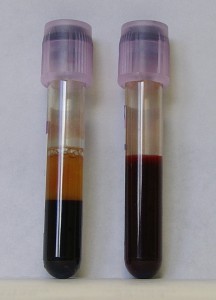
Do the cells in this blood harbor a potentially harmful gene? If the answer is yes, but the person it belongs to donated it for unrelated research, it's not yet clear when - or how - to tell them. (JHeuser/Wikimedia Commons)
Snippets of tissue, vials of blood and tubes of DNA from hundreds of thousands of people sit in freezers and liquid nitrogen tanks right now in laboratories across the globe. They come from people like you and me, donated in the hope that our genes researchers will be able to glean insights for the next breakthroughs for diseases common and rare.
Whenever we sign a consent form and roll up our sleeve, we don’t just join the community of research. We also become part of a debate that has been raging among researchers, clinicians and ethicists for years: What if our DNA sequence turns up bad news unrelated to the research we signed up for?
“There is an emerging consensus among genomics researchers that we have an ethical responsibility to tell participants if we find, in the course of a research study, genetic variations that could impact their healthcare decisions,” says Kenneth Mandl, who directs the Intelligent Health Laboratory (IHL) in the Children’s Hospital Informatics Program (CHIP).
This responsibility can quickly turn into a numbers problem – a massive administrative burden. Consider that there are more than 104,000 human genetic variations now cited in the medical literature with links to human disease.
How can we whittle that down to an actionable, relevant number? Many have tried. For instance, two years ago, a working group convened by the National Heart, Lung, and Blood Institute (NHLBI) provided some guidance, recommending four criteria for notifying patients about a genetic finding:
- The genetic finding has important health implications for the participant, and the associated risks are established and substantial.
- The genetic finding is actionable; that is, there are established therapeutic or preventive interventions or other available actions that have the potential to change the clinical course of the disease.
- The test is analytically valid and complies with all applicable laws.
- During the informed consent process or subsequently, the study participant has opted to receive his/her individual genetic results.
No one has yet pinned down how many DNA variants meet these four criteria, and it may be that no one ever will. But a team led by Mandl and Christopher Cassa, an instructor in the IHL, recently calculated a baseline set of figures to work from while the community – through efforts like the CLARITY Challenge – works out standards and best practices for reporting results back to research participants.
Mandl’s team started with a representative sample of gene variants associated with disease, and twice reviewed them against the four NHBLI criteria: first using a strict interpretation of the criteria (that is, the presence of the variant equals disease), and again with a broader interpretation (allowing that the presence of the variant may equal some level of disease). Based on their calculations, they concluded that between about 7 and 11 percent of the 104,000 DNA variants would meet the ethical requirements for patient notification.
What does that mean in absolute numbers? “If we go by the conservative estimate, there are about 7,200 gene variants that an investigator should discuss with a research subject should those variants appear in the subject’s genome sequence,” says Mandl.
“In the more liberal estimate,” Cassa adds, “that number rises to just under 11,100.”
Keep in mind that these numbers are not set in stone; in fact, Mandl and Cassa expect them to increase over time. “As more and more individuals have their genome sequenced and larger numbers of genome-wide association studies are published, the number of variants will only go up,” Mandl explains. “Roughly another 10,000 variants with some level of disease association are identified every year, and that number may be low.
“By 2015,” he continues, “there could be between 150,000 and 190,000 disease associated variants in the literature. We think that more than 16,000 of those might meet the criteria for notification to research subjects.”
Eleven thousand to 16,000 gene variants is a lot. And as one Bloomberg reporter recently discovered, just finding out that your genome harbors a variation associated with disease doesn’t mean that the disease will actually strike, and, for some variants, the true risk still isn’t completely understood.
“Genomics works at a daunting scale,” says Mandl. “Resolving this dilemma will at the very least require effective information management methods for taming the data and reporting practices that balance ethical responsibility with feasibility, clinical validity, and the desire of research subjects to know their genetic findings.”
[Ed. note: If you, your laboratory, or your company is in participating in the CLARITY Challenge – a collaborative effort to assure communication of accurate, reliable interpretation of genomic data to patients and physicians – then you have one more week to submit your application. Learn more on the Challenge website.]








